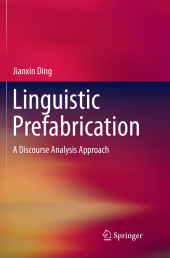 Neuerscheinungen 2019Stand: 2020-02-01 |
Schnellsuche
ISBN/Stichwort/Autor
|
Herderstra▀e 10
10625 Berlin
Tel.: 030 315 714 16
Fax 030 315 714 14
info@buchspektrum.de |

Jianxin Ding
Linguistic Prefabrication
A Discourse Analysis Approach
Softcover reprint of the original 1st ed. 2018. 2019. xiii, 158 S. 13 SW-Abb. 235 mm
Verlag/Jahr: SPRINGER, BERLIN; SPRINGER SINGAPORE; SPRINGER 2019
ISBN: 9811349851 (9811349851)
Neue ISBN: 978-9811349850 (9789811349850)
Preis und Lieferzeit: Bitte klicken
This book presents an innovative exploration of linguistic prefabrication in the travel advertising discourse from a functional perspective. Most of the previous studies on prefabricated language have adopted a structural, systematic point of view. This study, however, aims at exploring its functions in discourse. The material examined here is the discourse of travel advertising, which has become one of the candidates for ┤late modern discourse par excellence┤ and rarely been discussed before.
The study covers a wide range of topics, essentially attempting to model linguistic idiomaticity in Systemic Functional Grammar. It assesses how the two fundamental principles of language use, the ┤idiom principle┤ and the ┤open-choice principle┤, interact with each other to construct English texts. As a counterweight to the traditional structural approach to collocations and idiomatic expressions, this study investigates the ┤phraseology┤ of the register of travel advertising, and explores prefabrication and conventionalization in language use and human behavior. It seeks to answer the age-old question of whether human beings are ┤primarily like buses, which travel along regular routes┤ or ┤like taxis, which move about freely┤. Ritualization, as sociological and anthropological theory have long since recognized, is simply characteristic of all aspects of human behavior and its contexts.
1 Introduction 1.1 The Research Tradition of Prefabricated Language 1.2 The Scope of This Dissertation: Collocation Defined 1.3 The Purposes of This Dissertation 1.4 Data Collecting: The Travel Advertising Corpus 1.5 Methodological Issues 1.6 The Organization of This Dissertation 2 A Review of Related Literature on Collocation: Firthianism and Beyond 2.1 Introduction 2.2 J. R. Firth: ┤You Shall Know a Word by the Company it Keeps┤ 2.3 M. A. K. Halliday: Lexis as a Linguistic Level 2.4 T. F. Mitchell: Linguistic Goings-on 2.5 J. Sinclair: Corpus Linguistic Approach to Collocation 2.6 Summary 3 Theoretical Framework: Collocation in Sys temic Functional Perspectives 3.1 Introduction 3.2 Modeling Lexis in Systemic Grammar 3.3 Collocations in Functional Grammar 3.4 Collocation and Register 3.5 Summary 4 Ideational Collocations: Conventional Ways of Representing the World 4.1 Introduction 4.2 Representing the World: Grammar, Single Word and Collocation 4.3 The Experiential Grammar of Ideational Collocations 4.4 Conventionalization in Travel Advertising 4.5 Ideational Collocations and Attitude in Discourse 4.6 Summary 5 Interpersonal Collocations: Dialogue, Conviviality and Narrative Voices 5.1 Introduction 5.2 Interpersonal Collocations: An Overview 5.3 The Dialogic Nature of Travel Advertising 5.4 Interpersonal Collocations as Markers of Conviviality 5.5 Narrative Voices: Language Reporting in Travel Advertising 5.6 Summary 6 Textual Collocations: Logical and Temporal Cohesion 6.1 Introduction 6.2 Cohesion in Discourse: General Issues 6.3 Idiomatic Collocations: the Logic of Travel Advertising 6.4 Temporal Collocations: The Chronology of Travel Stories 6.5 Texualization: Another Hypothesis 6.6 Summary 7 Collocational Metaphors: Between Creativity and Prefabrication 7.1 Introduction 7.2 Problems with Referential Interpretations of Metaphor &nbs p; 7.3 A Syntagmatic Perspective on Metaphor 7.4 The Syntax of Collocational Metaphors 7.5 Metaphorical Functions in Travel Advertising 7.6 Between Creativity and Prefabrication: A Discussion 7.7 Summary 8 Conclusions and Implications 8.1 Introduction 8.2 Answers to the Three Research Questions 8.3 Reflections on Modern Linguistic Theory 8.4 Teaching Collocation: Where Grammar and Lexis Meet 8.5 Postscript References Appendix1 Appendix2


